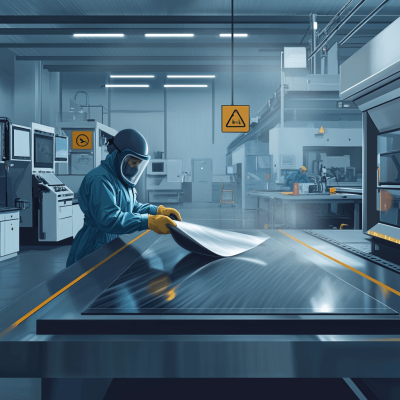Introduction
Machining carbon fiber is common in many industries due to its exceptional strength-to-weight ratio and versatile applications. From aerospace to automotive, carbon fiber components are prized for their durability and lightweight properties. However, machining carbon fiber poses significant health and safety risks if proper precautions are not taken. This article aims to provide essential safety tips for machining carbon fiber, ensuring a safer working environment for all involved.
When carbon fiber is machined, it produces fine dust and fibers that can be hazardous to health if inhaled or if they come into contact with skin. The abrasive nature of carbon fiber can also lead to rapid wear and tear on equipment, further emphasizing the need for stringent safety measures. Understanding these risks and implementing appropriate safety protocols is crucial for protecting workers and maintaining a safe workspace.
In this guide, we will explore key safety considerations, including the use of personal protective equipment (PPE), proper ventilation and dust control, safe handling and disposal of carbon fiber waste, and best practices for machining techniques. By following these guidelines, you can mitigate the risks and promote a healthier, safer work environment.
Understanding the Risks of Machining Carbon Fiber
Health Hazards
Machining carbon fiber produces fine dust and fibers that can pose significant health hazards. Inhalation of these particles can lead to respiratory issues, such as bronchitis or long-term respiratory diseases. Additionally, carbon fiber dust can irritate the skin and eyes, causing discomfort and potential long-term damage.
- Respiratory Issues: Fine carbon fiber dust can penetrate deep into the lungs, leading to respiratory problems.
- Skin and Eye Irritation: Direct contact with carbon fiber dust can cause itching, redness, and irritation.
Environmental Risks
Improper disposal of carbon fiber waste can lead to environmental pollution. Carbon fiber is not biodegradable, and if waste is not correctly managed, it can contribute to environmental contamination.
- Non-Biodegradable Waste: Carbon fiber does not break down naturally, leading to long-term environmental impact.
- Potential Contamination: Improper disposal can contaminate soil and water sources.
Equipment Wear and Tear
Carbon fiber is highly abrasive, which can lead to rapid wear and tear on machining equipment. Tools that are not designed for carbon fiber can become dull quickly, reducing their effectiveness and potentially causing safety issues.
- Tool Degradation: Regular tools may wear out quickly, leading to increased costs and safety hazards.
- Machining Challenges: Dull tools can cause poor quality cuts and increased risk of accidents.
Personal Protective Equipment (PPE)
Respiratory Protection
Using proper respiratory protection is crucial to prevent inhalation of harmful carbon fiber dust.
- Types of Masks and Respirators: N95 respirators or higher-grade masks are recommended.
- Proper Fitting and Usage: Ensure masks fit snugly and are worn correctly at all times during machining.
Eye and Skin Protection
Protecting eyes and skin helps prevent irritation and long-term damage.
- Safety Goggles and Face Shields: Wear goggles with side shields or full-face shields.
- Protective Clothing and Gloves: Use long sleeves, gloves, and coveralls made from materials resistant to carbon fiber penetration.
Hearing Protection
Machining processes can be noisy, requiring hearing protection.
- Earplugs and Earmuffs: Use appropriate hearing protection to prevent noise-induced hearing loss.
- Importance of Protecting Hearing: Prolonged exposure to high noise levels can cause permanent damage.
Proper Ventilation and Dust Control
Local Exhaust Ventilation (LEV) Systems
LEV systems help capture and remove airborne contaminants at the source.
- Benefits and Setup: Reduces airborne dust concentration; setup includes hoods, ducts, and filters.
- Maintenance and Inspection: Regularly check and maintain the system to ensure efficiency.
Dust Collection Systems
Effective dust collection prevents dust accumulation and improves air quality.
- Types of Dust Collectors: Portable units, central systems, and cyclone separators.
- Proper Disposal and Handling of Collected Dust: Follow regulations for hazardous waste disposal.
Clean Work Environment
Maintaining cleanliness minimizes risks.
- Regular Cleaning Schedules: Implement routine cleaning to prevent dust buildup.
- Use of HEPA-Filtered Vacuum Cleaners: HEPA filters effectively capture fine particles.
Safe Handling and Disposal of Carbon Fiber Waste
Handling Techniques
Proper handling reduces dust generation.
- Minimizing Dust Generation: Handle waste gently to prevent dust release.
- Proper Bagging and Labeling: Seal waste in labeled bags for safe disposal.
Disposal Methods
Dispose of waste responsibly.
- Compliance with Local Regulations: Adhere to laws regarding hazardous waste.
- Environmentally Friendly Practices: Explore recycling options where available.
Best Practices for Machining Carbon Fiber
Tool Selection and Maintenance
Using the right tools enhances safety and efficiency.
- Suitable Tools for Carbon Fiber: Use diamond or carbide tools designed for abrasive materials.
- Regular Inspection and Replacement: Check tools for wear and replace as needed.
Machining Techniques
Proper techniques reduce risks.
- Proper Feed Rates and Cutting Speeds: Adjust settings to minimize heat and dust.
- Reducing Heat Generation: Use coolants or lubricants suitable for carbon fiber.
Emergency Procedures
Being prepared ensures quick response.
- First Aid Measures for Exposure: Train staff on handling exposures to dust or fibers.
- Fire Safety and Prevention: Keep appropriate fire extinguishers accessible.
Conclusion
Recap of Essential Safety Tips
- Use Proper PPE: Respiratory, eye, skin, and hearing protection are vital.
- Implement Ventilation and Dust Control: LEV systems and regular cleaning reduce airborne dust.
- Handle and Dispose of Waste Safely: Follow regulations and minimize environmental impact.
- Adopt Best Machining Practices: Use appropriate tools and techniques.
Emphasis on the Importance of Safety in Carbon Fiber Machining
Prioritizing safety protects workers’ health and ensures a productive work environment. Awareness and proper implementation of safety measures are essential.
Encouragement to Implement Safety Measures in the Workplace
By adopting these safety tips, organizations can mitigate risks associated with machining carbon fiber, promoting well-being and efficiency.


![[object Object]](https://carbonfiber-cnc.com/wp-content/uploads/2023/05/wendy.jpg)